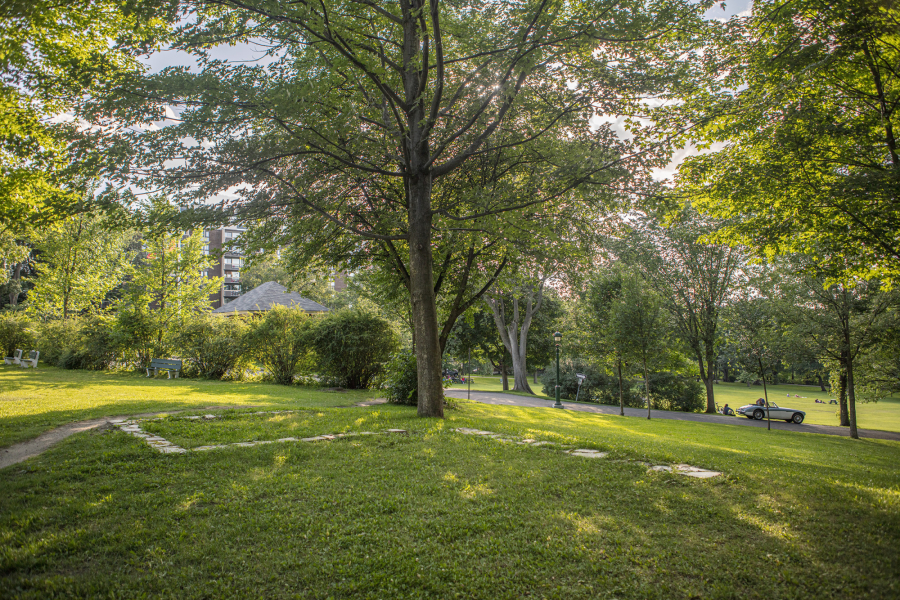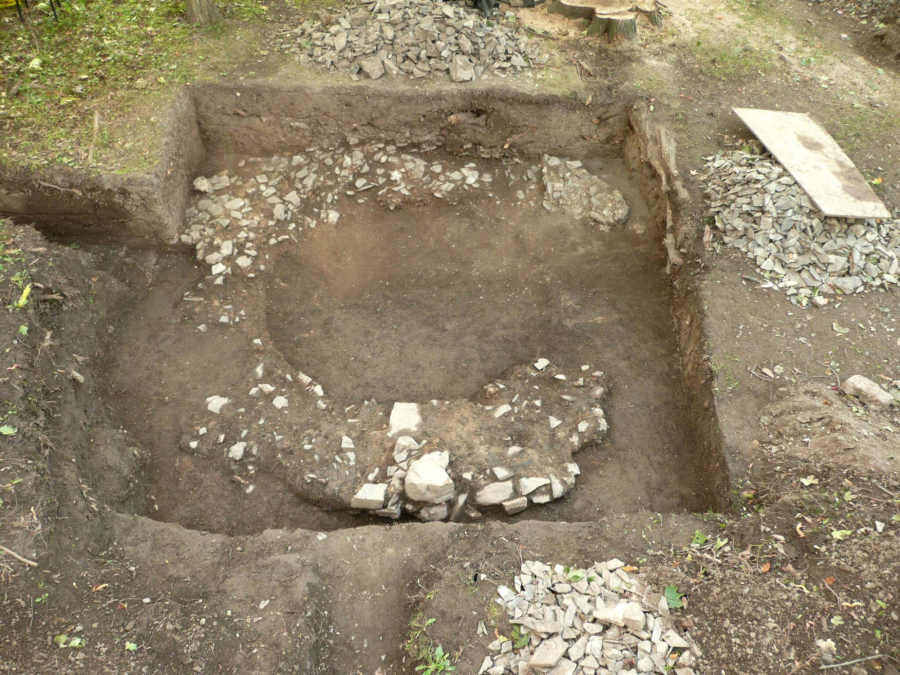From the Pinguet House to Dumont Mill
For a long time, all the land lying a few kilometres from the walls of Québec City was considered the outskirts. This was true of the vast stretch of land acquired in 1639 by Pierre Delaporte, a trading clerk. He built a main dwelling that seems very small to us today, but was large enough to sleep and eat in, at just under 10 m² inside. In 1646, merchant Henry Pinguet bought part of this land, located between Grande Allée and the Saint-Charles River, and expanded the house to add two bedrooms. A map dated 1685 shows the land as belonging to Pinguet’s widow.
A few decades later, in 1705, merchant and tanner Jacques Jahan purchased a portion of the land situated north of what is now Chemin Sainte-Foy. There, he built a tannery, a house and a wooden windmill. Then, in 1741, it was acquired by Jean-Baptiste Dumont, a wholesale merchant, who replaced the wooden mill in 1747 with a stone mill for grinding bark. The ground tree bark was used for tanning hides and turning them into durable leather. That same mill would prove pivotal just over a decade later, during the Conquest of New France.
The Dumont Mill and the Battle of Sainte-Foy
In 1759, Québec City prepared for war and then endured a siege. After a defeat on the Plains of Abraham in September, the French army retreated to Montréal for the winter. François-Gaston de Lévis, who took command of the troops following General Montcalm’s death, was determined to try and retake Québec City. The plan was to launch a surprise attack early in the spring.
By late April 1760, the ice had only just begun to break up enough to allow ships to sail. Snow still covered many areas, and the ground was muddy from the thaw.
On the British side, the soldiers spent winter within the city walls alongside the local population. The season was harsh for both armies: Food supplies were insufficient, and disease had severely weakened the soldiers.
General James Murray had been commanding the British forces in Québec City since the previous fall. Informed of the approaching French army, he was ready by April 28, 1760. He ordered more than 20 cannons to be positioned on the Buttes-à-Nepveu, on the Plains of Abraham (near what is now the Plains of Abraham Museum). As the first French soldiers began to advance, Murray—aware that he was outnumbered—chose to strike first, before the French could fully deploy their forces and form a proper battle line.
Once again, the battle took place on the heights of Québec City. It spanned much of the width of the promontory, though farther west than the battle of September 1759. Most of the fighting occurred around what is now Des Braves Avenue and Des Braves Park, today part of the Battlefields Park.
- 7 000 men with the French army
- 3 400 with the British army
The mill built by Jean-Baptiste Dumont, located on the site of what is now Des Braves Park, became a key location during the battle. Positioned at the highest elevation in that part of the terrain, it offered an excellent vantage point over the battlefield. Furthermore, the mill was built with solid stone walls nearly a metre thick. During the fighting, it became a strategic position to hold, and both sides sought to control it for that reason.
The combat was intense and at close quarters, often fought with bayonets. The battle lasted around three hours, at the end of which General James Murray ordered a retreat. The British army fell back behind the walls of the fortified city. The battle left several hundred dead and wounded on both sides, but especially among the British. Although the Battle of Sainte-Foy was a French victory, it was not enough to retake the city. De Lévis’ men therefore prepared for a siege just outside the fortifications.
The mill after the British took Québec City
With the surrender of Montréal in September 1760, the following years were spent under military rule, before the territory that was once New France officially became British with the signing of the Treaty of Paris.
With this transfer of power, many high-ranking British officials took possession of lands across the territory. Among them was James Murray, who acquired several seigneuries. In 1774, a few years after being recalled to England, he leased all of his lands in the province of Quebec to a man named Henry Caldwell.
Henry Caldwell, a former officer in the British army and well connected within military leadership, had played a key role in the campaigns of 1759–1760 and during the American attack on Québec City in 1775. This brought him considerable wealth. One of the estates he leased from Murray was known at the time as the Sans-Bruit estate, located near Dumont Mill. Today, Villa Sans-Bruit on Brown Avenue still bears that name.
In the decades that followed, Caldwell became a major landowner. He owned and rented out numerous plots in the outskirts of Québec City, on the south shore and farther west. He served on the legislative council and built his fortune in part through his many mills for grinding wheat and, later, for sawing timber.
In 1781, Caldwell acquired Dumont Mill and the surrounding land. The Battle of Sainte-Foy had left the mill badly damaged, and he chose not to preserve it. Archaeological digs carried out in 2010 and 2011 uncovered the stone foundations of the mill, east of the terrace in Des Braves Park.
In 1854, the Société Saint-Jean-Baptiste de Québec purchased the land near the former Dumont Mill to erect a monument honouring those who fought in the Battle of Sainte-Foy. This site is now part of Des Braves Park, managed by the National Battlefields Commission.
Images :
- Remnants of the Dumont Mill. 2010
- The Canadian Epic, Lévis [detail] 1908, National Battlefields Commission
- Caron, Gitane. Sketch depicting the Battle of Sainte-Foy [detail] Drawing. 2017, National Battlefields Commission



